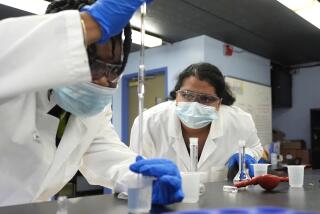Nuclear site now a tourist hot spot
Aplatoon of double-crested cormorants took flight from the eastern shore of the Columbia River, skimming the sun-sparkled surface as two slender white egrets stood in the nearby shallows, hunting small fish hiding in the reeds.
Twenty kayakers, mostly tourists from the Pacific Northwest, paddled along, letting the steady current do most of the work. They coasted past mule deer grazing on the shore, coyotes stalking the sandy beaches and cliff swallows buzzing the nearby white bluffs.
But the main attraction was on the western shore: several bland, industrial-gray structures and towering smokestacks, a collection of buildings that gave birth to America’s atomic age.
Welcome to the Hanford Reach, where one of the last free-flowing stretches of the Columbia River encounters America’s most contaminated nuclear site. Along this flat, mostly treeless scrubland, the U.S. government built nine reactors between 1943 and 1963, including the historic “B” plant that produced the world’s first weapons-grade plutonium for the nuclear bomb dropped on Nagasaki, Japan, in World War II.
The reactors have leaked so much radioactivity into the air, land and water that the contamination caused by the Three Mile Island nuclear accident seems trivial by comparison. Yet merchants and tourism directors here in southern Washington state see the river and the shuttered reactors as a growing tourist draw.
Imagine a theme park next to the Chernobyl nuclear power plant.
As odd as it may sound, the idea seems to be working at Hanford.
The popular kayak tours are one example. Pat Welle, owner of Columbia Kayak Adventures, who leads two or three groups each month past the nuclear site, said her business had more than doubled since she started it in 2004. A jet-boat tour operator plans to add a second boat, and the river hosts several bass fishing tournaments each year.
“I think the attraction is the unique combination of scenery -- the white bluffs and the wildlife -- and that odd collection of nuclear sites,” Welle said.
The reactors have long been shut down, but the surrounding land rumbles with bulldozers, dump trucks and crews in radiation suits working on a $2-billion-a-year cleanup project -- the most expensive such project in the world, according to the U.S. Department of Energy.
The irony is that although the reactors contaminated hundreds of acres, government restrictions on access left the surrounding lands largely undisturbed for more than 40 years, allowing wildlife to flourish.
The effort to make the Hanford Reach a tourist hot spot got a boost in 2000, when President Clinton proclaimed 195,000 acres along the river and around the nuclear site a national monument. About 60,000 people now visit annually, including anglers, hikers, birders and history buffs.
That number is likely to grow under a plan by the National Park Service to upgrade boat launches and picnic sites and to open the B reactor for regular public tours. Interior Secretary Dirk Kempthorne is also expected this month to approve a recommendation by the park service to declare the B reactor a National Historic Landmark.
“I would like to see the B reactor preserved, because I would like that story to be told,” said Kris Watkins, who heads the Tri-Cities Visitor & Convention Bureau, representing the nearby cities of Richland, Kennewick and Pasco. “I think it’s a fascinating story.”
The story began in 1942 when the U.S. Army Corps of Engineers began searching for a plutonium production site for the then-secret Manhattan Project. With large tracts of land and access to large volumes of water to cool the reactor, the Hanford area along the Columbia River seemed perfect.
The only problem: About 1,200 people in the small agricultural towns of Hanford, White Bluffs and Richland called it home.
But everyone had to sacrifice for the war effort. That is what the U.S. Department of War said in 1943, when it condemned the land, evacuated the towns and leveled all but a few buildings to make way for the nuclear facilities. Some residents had just a few days’ notice to leave. Only the town of Richland was rebuilt and reincorporated, in 1958.
America’s first large-scale nuclear reactor was built in only 11 months. Most workers at the B reactor were clueless about what they were developing until the atomic bomb was dropped on Nagasaki. Later, a headline in the local paper announced: “Peace! Our Bomb Clinched It!”
During the next 20 years, the federal government built eight more reactors along the Columbia River in a 586-square-mile area known as the Hanford site. The reactors became the area’s largest employer, with more than 51,000 local jobs.
But by the end of the Cold War, all the reactors had been shut down, and the challenge fell to the Department of Energy to clean up the contamination.The legacy of Hanford is now measured in half-lives.
In 1948, a dike at a reactor waste pond broke, dumping 28 pounds of uranium into the Columbia River. A federal report released in 1992 estimated that 685,000 curies of radioactive iodine-131 had been released into the river and air from the Hanford site between 1944 and 1947.
In comparison, about 43,000 curies of radioactive krypton and less than 20 curies of the particularly hazardous iodine-131 were released in the 1979 Three Mile Island nuclear accident. Exposure to iodine-131 can increase the risk of thyroid cancer.
Today, scientists and biologists extensively test almost every creature along the river, whether a tadpole or a deer.
Critics say that tourists who occasionally visit the Hanford Reach should be safe but that locals who regularly swim in, go boating on and eat fish from the river may have a higher risk of exposure to harmful contaminants, a charge that state health officials dispute.
“Would I eat fish out of that river? No way,” said Gregory deBruler, an environmental health specialist with the Columbia Riverkeeper, a nonprofit environmental group dedicated to protecting the river.
A spokeswoman for the Washington State Department of Health’s Office of Radiation Protection said that tests of fish from the river had not detected levels exceeding public health standards for radiation.
The task of cleaning up the mess has been daunting, involving the removal of millions of gallons of contaminated ground water, hundreds of tanks of liquid radioactive waste and thousands of tons of spent nuclear fuel. Even the tumbleweeds that blow across the site are scanned for radiation before being carted away for disposal.
Department of Energy officials say they don’t know how long the cleanup work will take because they still don’t know the extent of the contamination. The agency has built a massive landfill at the Hanford site to hold up to 10 million tons of contaminated materials. The still-radioactive cores of the reactors will be entombed in 4-foot-thick walls of concrete and steel for a minimum of 75 years. All the nuclear facilities except the B reactor will be off-limits to the public while the soil cleanup continues.
The cleanup project has become the second-largest employer in the region, behind agriculture, generating about 11,000 jobs. But locals hope that when the cleanup is done, tourism will take over as the region’s new economic engine.
The jet boat roared to life at the wooden dock at Howard Amon Park in Richland and rocketed up the Columbia River toward the Hanford Reach National Monument. Seated inside, 15 tourists craned their necks over the side, the brisk morning air blowing in their faces.
The high-speed, 60-mile tour of the river extends to the heart of the monument, where radiation warning signs and shuttered nuclear reactors dot the flat landscape.
Clarence Reynolds, a contractor for the city of Walla Walla, took the boat tour on a recent Saturday morning with a group of friends to celebrate his 73rd birthday. Along the way, he spotted deer grazing along the shores, a coyote sauntering in the shadows of 300-foot bluffs, white pelicans feeding along a beach and several blue herons and white egrets soaring over the river.
Near a popular fishing spot called Ringold, the boat passed an angler who had hooked a 4-foot sturgeon, a prehistoric-looking fish that can grow up to 15 feet long in these waters.
A few minutes later, the boat’s captain stopped the engines near the shore so the tourists could get a closer look at two osprey chicks squawking in a twig nest perched on an old telephone pole.
Reynolds took the tour to see the wildlife, the scenery and the historic reactors. And it didn’t disappoint. “It was great,” he said afterward. “Awesome.”
Even more popular than the boat trips are the occasional tours of the historic B reactor offered by the Department of Energy. Visitors can see the original controls, dials and nuclear core that produced the world’s first weapons-grade plutonium.
But getting a spot on the tour is mostly a matter of luck and mouse-clicking speed. When the federal agency opens online registration, the tour fills up in five or six minutes. Visitors, according to the Energy Department, are mostly history buffs and World War II veterans who want to see the reactor that helped end the war.
Even though the agency has increased the number of tours from 18 last year to 48 this year to meet the demand, all those for the rest of 2008 have been filled. If the National Park Service takes over the tours, they would be expanded significantly.
Kayak outfitters and tour operators say that despite Hanford’s contamination problems, few visitors express fear about swimming, fishing or boating near the reactors.
Grant Nakamura, a computer programmer from Kennewick who took a kayak tour of the Hanford Reach, said that he had faith in the crews monitoring and cleaning up the land.
“People in the tri-cities know what it’s all about, and they are not worried,” he said.
In fact, Hanford’s contamination is fodder for some lighthearted humor in nearby Richland.
At the Octopus’ Garden, a T-shirt and novelty store, customers can buy shirts emblazoned with the radiation warning symbol and expressions such as “I came, I saw, I glow,” “Hanford is a rad place to work” and “Kiss me, I’m hot.”
And if the Hanford site becomes the tourist hot spot that locals envision, visitors can pick up souvenirs at the Octopus’ Garden and then walk a few blocks to the Atomic Ale Brewpub and Eatery, where they can order atomic chicken skewers, chocolate containment cake and Atomic Amber beer, which is promoted as “radiating with flavor.”
--
More to Read
Start your day right
Sign up for Essential California for news, features and recommendations from the L.A. Times and beyond in your inbox six days a week.
You may occasionally receive promotional content from the Los Angeles Times.







